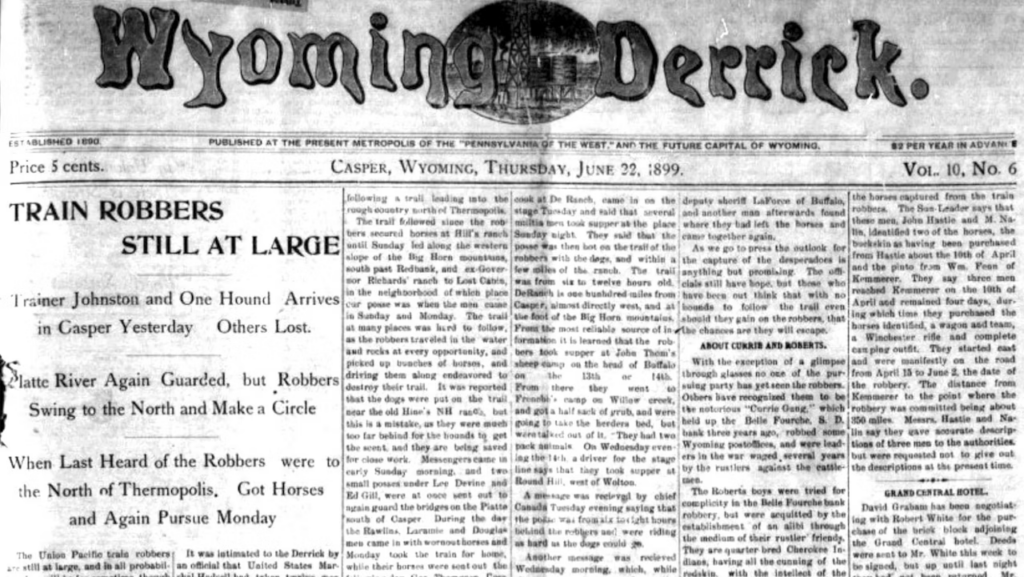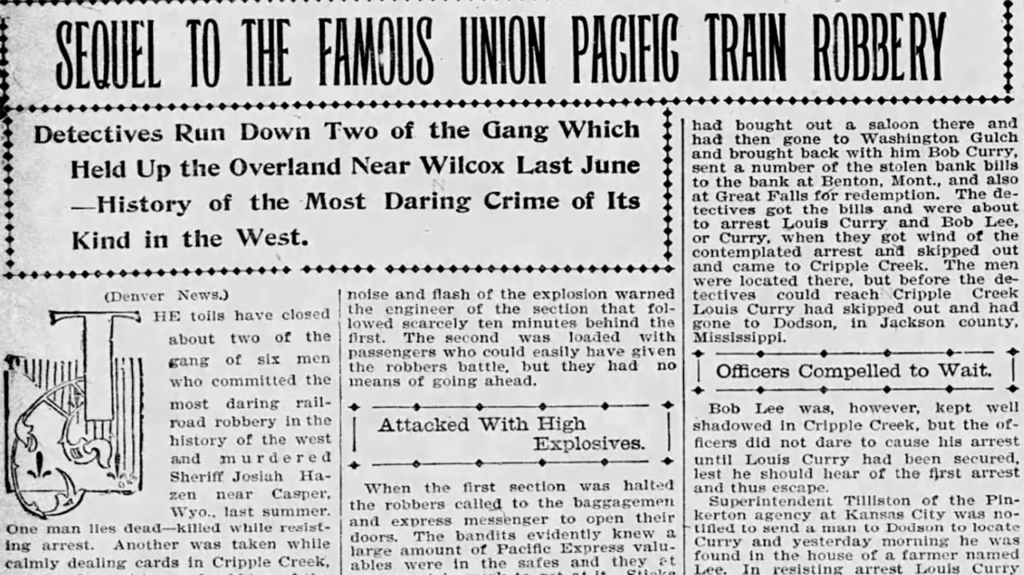Fascinating historical tale, but the conspiracy minded person that I am, I couldn’t help but notice how intertwined the Masons are in the story. Consequently, in the secret society of Freemasonry you learn at the 33rd level you work for and follow Satan (I surmise this 33 is significant because 33% of the angels rebelled against God). They’re an organization that has been involved heavily in the pollution of Christianity with liberal doctrines among many other Satanic schemes. And with the concentration of wealth and the extremely powerful OCGFC billionaires, they seem to have decreased in importance, but who really knows. Consequently, Billy Graham, once sponsored by the Rockefellers in his TV crusades (cited in a F. William Engdahl book), was a Mason, and he was a terrible influence on Christianity.
Converse County Sheriff Josiah Hazen became a notch on the belt for a member of the notorious Hole in the Wall Gang in 1899. He was gunned down after tracking them following a train robbery.
By Dale Killingbeck

The Union Pacific train traveling half a mile west of Wilcox, Wyoming, was flagged down by a lantern in the darkness at 2:15 a.m. on Friday, June 2, 1899.
The engineer named W. R. Jones brought the locomotive to a stop thinking the bridge ahead must be out. Instead, two men wearing white masks jumped up in the cab and ordered the train to pull forward to the bridge.
“One of the robbers informed him there was enough dynamite down there to blow him to hell,” the Carbon County Journal reported on June 3, 1899. A masked man jumped off, lit the fuse to the dynamite, hopped back on board and ordered the train forward.
So begins of one of Wyoming’s most notorious train heists involving members of the Hole in the Wall Gang. It would lead to the death of one of the state’s most beloved sheriffs and cause a manhunt that would see the Wyoming governor confer with the president to get federal help to bring the criminals to justice.
One prominent newspaper of the time even called the train heist, pulled off by blowing up a safe — and the rail car it was in — “the most daring crime of its kind in the West.”
For Converse County Sheriff Josiah Hazen, his third year in office had already been active.
The Natrona County Pioneer reported that he had arrested a con man in Glenrock for the Natrona County sheriff. The Daily Deadwood Pioneer-Times in Deadwood, South Dakota, reported June 8, 1899, that Hazen had been in the city that winter to arrest a man wanted for forgery.
When Hazen learned of the June 2 train robbery, he joined the hunt by taking a train to Casper with Union Pacific detectives on June 3.
It proved to be a pursuit for justice that would lead to the sheriff being gunned down by a member of the notorious outlaw gang.
What the lawmen knew was that six masked men robbed the first section of the United Pacific train after forcing it across the bridge. They then dynamited the bridge — one robber clubbing the engineer who he thought was too slow getting the train across.
After the train was across the bridge, they separated the mail and express car and blew a hole in it. They put dynamite on top of the safe and blew a hole in it.
Unsigned Currency
Later reports showed among the booty was $3,400 in unsigned currency for the First National Bank of Portland and $34,000 in cash and $7,000 in valuables.
The bandits got on horses and headed north.
“Word was sent to Sheriff McDonald, and he started a posse to the scene,” the Carbon County Journal reported June 3. “Sheriff McDonald remained in Rawlins and late in the afternoon organized another posse to go north out of this city. The posse started out at 7 o’clock last evening headed for Brown’s Canyon.
“Posses were also started out from Laramie, Dana, Casper and Lander and the desperados may be surrounded and hemmed in so that it be impossible to escape.”
Hazen and the men on the train consulted with Natrona County Sheriff Oscar Hiestand on Saturday afternoon. While some of the lawmen took the train out of town, Hazen stayed in Casper.
On Sunday morning, a cowboy looking for his wayward horses rode into town and reported two men had pulled their weapons on him at an abandoned house
Both sheriffs believed they likely had their suspects. Because there were only a few good horses in town, Hiestand went out to the CY Ranch to find men and horses for a posse.
Hazen apparently found a horse and took six men who also had good horses with him, including Dr. J.F. Leeper.
The posse came together outside of town, tracked the outlaws and engaged in a brief battle. During that battle Hiestand lost his horse. But Hazen and those with him stayed in pursuit.
Near Teapot Creek on Monday, Hazen and his group found the outlaws’ horses and their boot tracks.
“Here they are, boys, right in here. Here are their tracks,” Hazen was quoted as saying in a Converse County weekly newspaper, Bill Barlow’s Budget. Shots rang out and the “brave sheriff fell, rose up and ran a short distance and fell again.”









Bullet Through Stomach
He received a round through his stomach and out his back near the spine. Men in the posse secured the area and a few went to try and find a wagon for Hazen. After several hours, Bill Barlow’s Budget reported they located one and used it to transport the sheriff to Casper.
Hazen wanted to be taken to Douglas. The railroad ordered a special car and engine to take him there. He died in his home the next day.
“It seldom falls to the lot of a newspaper to chronicle the death of a man who as so universally esteemed and loved by the people among whom he lived,” Bill Barlow’s Budget reported on June 7, 1899. “Possessed of a sunny disposition which led him to look on the bright side of life, Joe’s kind words and hearty laugh have brushed the cobwebs of care and sorrow from the mind of more than one of us during his residence among us.”
Wyoming Gov. DeForest Richards attended his funeral, which filled the streets of the city. Services were led by Masons and members of regional lodges arrived on special trains in addition to many members of the ranching community in the region.
As for the robbers, their horses worthless due to exhaustion, they managed to evade the posse on foot, steal horses from a nearby camp and make for the Hole in the Wall.
The hunt for the men intensified. Richards contacted President William McKinley about federal marshal assistance and ordered Wyoming Militia out of Buffalo to help in the hunt.
Attempts to pass the unsigned and torn notes put the Union Pacific and Pinkerton agency on the Curry brothers’ trails. They had allegedly been operating a saloon business in Harlem, Montana. Then fled.
A Curry Killed
In March 1900, a Pinkerton agent went to Dodson, Missouri, with lawmen to arrest a gang member named Lonny Logan alias Louis Curry, alias Louis Logan. He was killed in the arrest attempt. And Bob Lee, alias Bob Curry was arrested while dealing cards in Cripple Creek, Colorado, the Omaha World-Herald reported.
“Louis Curry has been a ‘bad man’ with a reputation in Montana for a number of years,” The Omaha World-Herald reported on March 4, 1900. “Bob Lee is also an all-around hold-up, tinhorn gambler and thief and has been arrested for numerous crimes in Missouri, New Mexico, Wyoming, Texas and Colorado.”
Lee was tried in Cheyenne, Wyoming, for the robbery but not for the killing of Hazen. He was convicted of robbing the train but not placing the lives of mail clerks in jeopardy. He got 10 years in prison.
No one was ever convicted of the killing of Hazen, though some suspected the shooter was Harvey Logan, also known as Kid Curry and George Curry. George Curry was allegedly killed in 1900 while rustling cattle in Utah. But his death was never officially confirmed.
Kid Curry allegedly died by suicide in 1904 after being shot by a posse following a train robbery.
Current Converse County Sheriff Clint Becker said the Hazen story and other feats by past Converse County sheriffs are inspiring and historic but not something he regularly thinks about. He said his department has embraced its western roots by making the Cowboy Code of Ethics part of the department’s policy.
One of the 10 principles is “be courageous.”
Former cowboy, ranch foreman, businessman and lawman Hazen impressed those he met with that quality.
“He was a friend to whom none appealed in vain, ever ready to extend the right hand of fellowship to a needy brother in distress,” the Masonic Ashlar Lodge No. 10 stated in a newspaper resolution in Bill Barlow’s Budget on June 21, 1899. “A man of high principle and unquestioned bravery.”